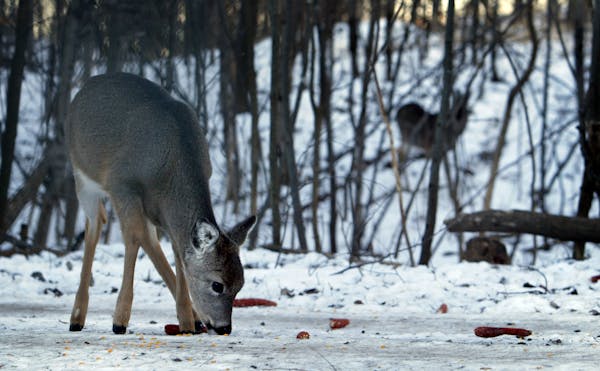The emergency feeding of winter-weary deer across a wide swath of northern Minnesota will begin in as soon as two weeks after state conservation officials Wednesday reversed their long-standing opposition to the controversial practice.
"I was pleasantly surprised and mildly shocked," said Mark Johnson, executive director of the Minnesota Deer Hunters Association (MDHA). He said Tom Landwehr, commissioner of the Department of Natural Resources, told him of the decision Wednesday morning.
The feeding program, Johnson said, "is the result of several meetings between our group and the DNR in recent weeks," and likely will be supported by many of the state's 500,000 deer hunters.
Feeding was approved for a region from about Cloquet, just south of Duluth, west to Cass Lake, north to International Falls, then south to Ely and Lake Vermilion and back to Cloquet. Feeding will not occur along the North Shore.
The effort is expected to cost about $170,000. It will be the first time the DNR has fed deer since the winter of 1996-1997, the second of two consecutive severe winters that devastated pockets of deer across the north.
Last week, DNR wildlife section chief Paul Telander said his agency was opposed to deer feeding, noting its steep cost and questionable effectiveness in saving deer from the ravages of extreme cold and deep snow, both of which have plagued northern Minnesota this winter.
Deer feeding also can cause deer to congregate, and could contribute to both the spread of disease and an increased likelihood the animals will be killed by wolves.
On Wednesday, however, Telander said the DNR wants to act "in good faith," using an emergency deer feeding account that whitetail hunters have paid into for about 15 years through 50-cent license surcharges.
Approved by the Legislature following the consecutive tough winters in the mid-1990s, the account originally was limited to feeding deer. But in 2004, its name and mission were expanded to allow it to also combat deer diseases.
In the years since, the DNR has spent as much as $10 million to monitor and eradicate chronic wasting disease and bovine tuberculosis in the state's whitetail herd.
Many deer hunters likely will support the feeding effort because the state's whitetail herd is already widely depressed. Landwehr, for instance, has said he hasn't seen a deer from his stand in four years. Johnson also reported seeing no deer while hunting last fall.
Two weeks or more might be needed to purchase the required special feed and transport it to distribution points in the north, Telander said, adding, "We want to get it going as soon as possible."
Volunteer groups, including MDHA chapters, are expected to deliver the feed by snowmobile to known deer wintering areas.
A special pellet mix that can be easily digested by deer is expected to be used. Straight corn, wildlife officials say, is too "hot" and could cause whitetails to bloat and die.
A previous agreement between the DNR and deer hunters called for emergency deer feeding to begin when the agency's "winter severity index" (WSI) reached 100 in specific areas by mid-February.
Last week the state's highest WSI was about 90 near International Falls, with recordings only in the 50s in northwest Minnesota and the 70s near Roseau, Telander said.
Historically, northern Minnesota legislators have supported deer feeding during severe winters — though they, like others, understand its limited reach.
"I'm not sure it helps all that much," said Rep. David Dill, DFL-Crane Lake. "On the other hand, deer in the north are hurting this year, and people want to help."
When winter ends, the DNR and deer hunters need to "have a conversation" about whether deer feeding is practical and effective, Telander said.
"We understand that dialogue needs to happen," Johnson said.
Dennis Anderson • 612-673-4424
Hopkins parents charged in 9-year-old daughter's deadly asthma attack

Back to blue: Lake Harriet Band Shell renovation almost finished

What St. Paul gardeners need to know about the city's new boulevard garden rules

